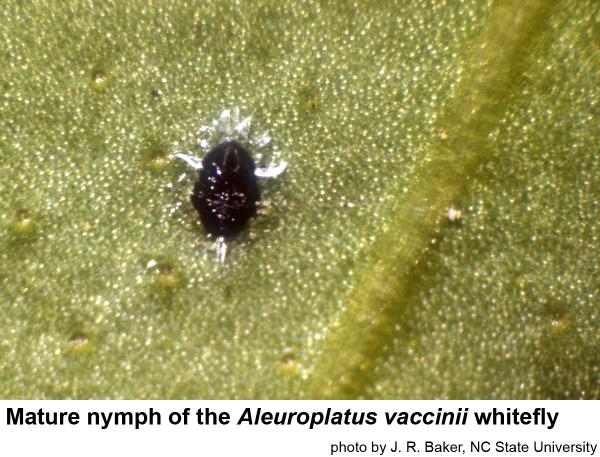Description and Biology
Aleuroplatus vaccinii is a whitefly occasionally reported from holly in North Carolina. This whitefly has no common name although its species name indicates it must have been described from blueberry (Vaccinium). Adults are probably white, moth-shaped insects about 1/16 inch long. Mature nymphs are jet black, somewhat shiny, and surrounded by a colorless, transparent secretion that is marked by white strands at the 2:00, 6:00, and 10:00 o'clock positions. Younger nymphs are pale to grayish yellow-orange. Almost nothing has been published about its biology. With most whiteflies, females slightly insert eggs into the lower surface of a leaf. A mobile first nymph (the "crawler") hatches and settles down on a suitable place to feed (usually the underside of the same leaf). With the next molt, the legs are lost, and the nymph becomes sessile, feeding in one place through the next immature stages. Adults emerge through the back of the last immature stage to mate, feed, and lay eggs for another generation. I presume the insect overwinters as nymphs on evergreen host plants. We probably have several generations per year in North Carolina. Nymphs and adults excrete honeydew that drips onto surfaces below. When numerous, enough honeydew may accumulate to foster sooty mold fungi. Infested shrubs may become dark with sooty molds.
Host Plants
Aleuroplatus vaccinii has been reported from Japanese holly, huckleberry, mountain laurel, blueberry, laurel, black gum, and a few other hosts from Florida to North Carolina. It may be a vector of blueberry stunt virus.
Residential Recommendations
Whiteflies are plagued with tiny parasitic wasps in the genus Encarsia. This may explain why Aleuroplatus vaccinii is not noticed more often. If these whiteflies are abundant enough to warrant insecticidal control, I recommend spraying the infested plant with one of the horticultural oils. Imidacloprid is a systemic insecticide that can be sprayed onto the shrub or applied to the soil beneath. One application should give control whereas it may take two applications of an oil to get complete control. In addition, several pyrethroid insecticides are now on the market for insect control in home landscapes. When used as directed, pyrethroids are very toxic to insects but are not particularly hazardous to humans and pets (other than fish—avoid using pyrethroids around pools, ponds, and streams). As Aleuroplatus vaccinii is rarely reported, the chances of it being resistant to pyrethroids or any insecticide is very low. Most big box stores carry all of these insecticides in their garden areas.
Other Resources
- An annotated check list of the world’s whiteflies (Insecta: Hemiptera: Aleyrodidae). Martin, J. H. and L. A. Mound. 2007. Zootaxa 1492. 84 pp.
- An Identification Guide to the Whiteflies (Hemiptera: Aleyrodidae) of the Southeastern United States. Hodges, G. S. and G. A. Evans. 2005. Florida Entomologist 88 (4): 518-534.
- Descriptions of nine species of Aleuroplatus from eastern North America (Homoptera: Aleyrodidae). Russell, L.M. 1944. Journal of the Washington Academy of Sciences, 34, 333–341.
- Insect and Related Pests of Flowers and Foliage Plants. Baker, J. R. ed. 1994 (revised). NC Cooperative Extension Service pub. AG-136.
- Extension Plant Pathology Publications and Factsheets
- Horticultural Science Publications
- North Carolina Agricultural Chemicals Manual
For assistance with a specific problem, contact your local N.C. Cooperative Extension Center.
This Factsheet has not been peer reviewed.
Publication date: Oct. 29, 2019
Reviewed/Revised: Aug. 19, 2024
Recommendations for the use of agricultural chemicals are included in this publication as a convenience to the reader. The use of brand names and any mention or listing of commercial products or services in this publication does not imply endorsement by NC State University or N.C. A&T State University nor discrimination against similar products or services not mentioned. Individuals who use agricultural chemicals are responsible for ensuring that the intended use complies with current regulations and conforms to the product label. Be sure to obtain current information about usage regulations and examine a current product label before applying any chemical. For assistance, contact your local N.C. Cooperative Extension county center.
N.C. Cooperative Extension prohibits discrimination and harassment regardless of age, color, disability, family and marital status, gender identity, national origin, political beliefs, race, religion, sex (including pregnancy), sexual orientation and veteran status.


